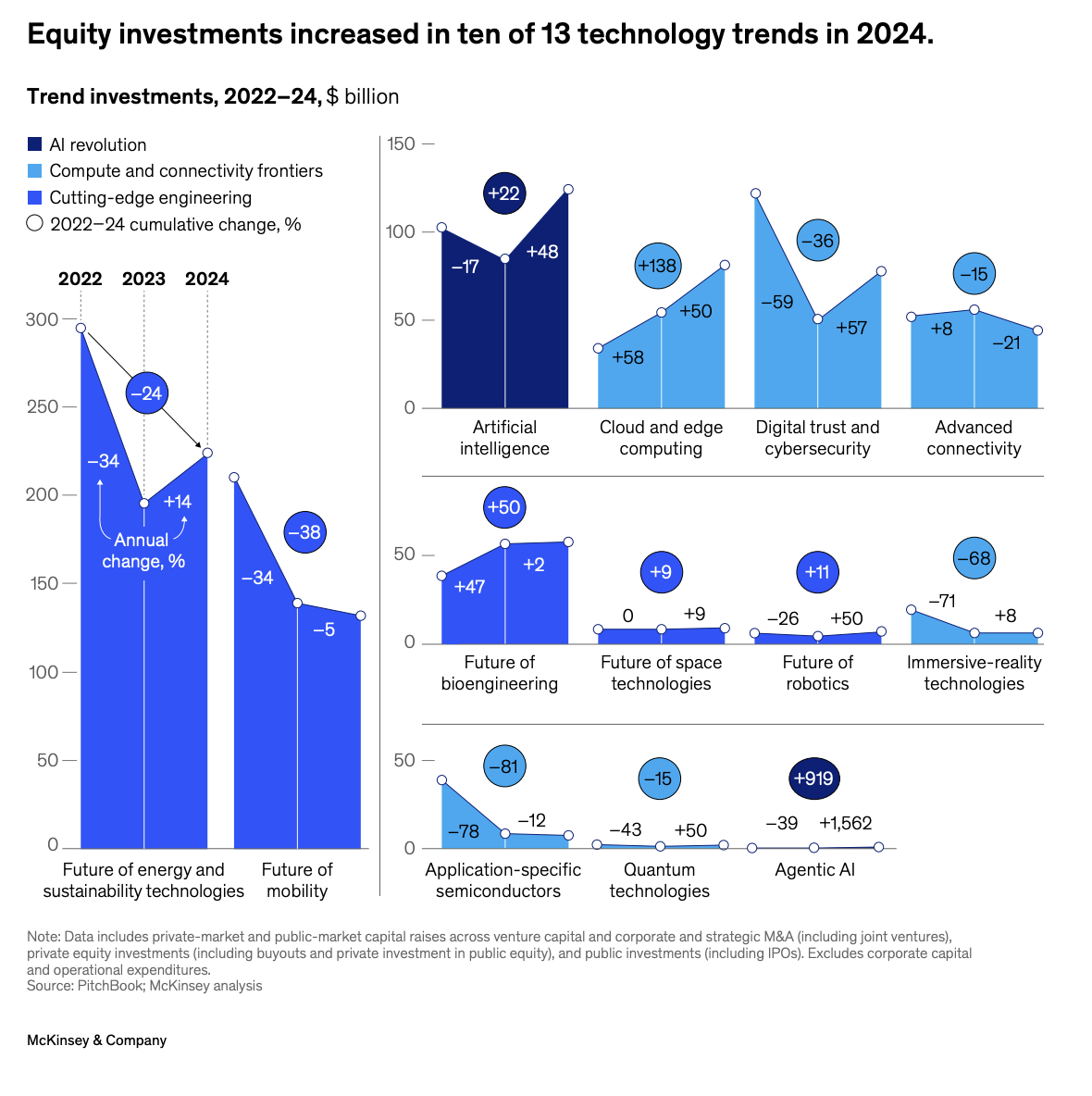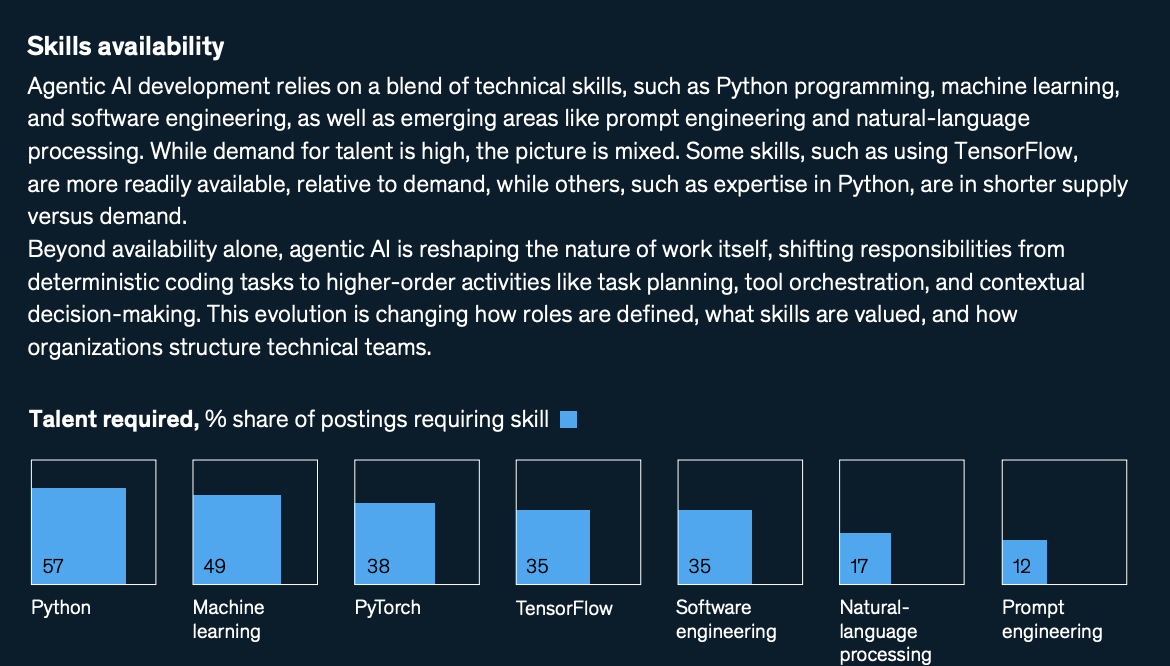AI takes charge: McKinsey’s 2025 tech hotlist
In its latest annual Technology Trends Outlook 2025 McKinsey & Company pulls no punches: emerging technologies aren’t just reshaping IT, they’re rewriting the rules for how enterprises operate, compete, and innovate.
The consulting firm’s just-released analysis highlights 13 “frontier” technology trends, the so-called “baker’s dozen”, that are set to drive major transformation in the year ahead. For IT professionals, McKinsey suggests, agility, readiness, and an AI-first mindset are now imperative for survival and success.
At the centre of the report, artificial intelligence, now treated as a unified trend encompassing both applied and generative AI, stands out as the main event. McKinsey doesn’t just call it a technology wave - AI has become a foundational amplifier for nearly every other trend, enabling breakthroughs across robotics, bioengineering, energy, and more.
Of particular note for 2025 is agentic AI. These are autonomous agents, built atop powerful foundation models, that can independently plan and execute complex, multistep tasks. Think virtual coworkers who don’t just provide answers, but act, coordinate workflows, and optimise business processes.
Though still in the early stages, equity investment in agentic AI has surged (US$1.1 billion in 2024 alone).
Beyond AI - the next frontiers
McKinsey groups the 13 trends into three clusters:
AI revolution agentic AI, and AI more broadly)
Compute & connectivity frontiers such as application-specific semiconductors, quantum, cloud/edge, cybersecurity)
Cutting-edge engineering including robotics, mobility, bioengineering, energy, space tech
Among these, several trends command priority for IT teams:
Application-specific semiconductors: The hunger for AI compute is fueling explosive growth in specialized chips (GPUs, ASICs, TPUs), with major cloud and tech vendors designing their own to reduce dependency on third parties and boost workload efficiency.
Cloud and edge computing: Enterprises are scaling up cloud adoption while also pushing compute and data storage to the edge. This distributed approach addresses latency, privacy, and cost, and is rapidly becoming essential as AI-powered workloads proliferate.
Digital trust & cybersecurity: As systems gain more autonomy and data traffic explodes, the threat landscape intensifies. AI is being harnessed both offensively and defensively, with a premium on explainable AI, zero-trust architectures, and robust governance frameworks.
Quantum technologies: While not yet mainstream, recent breakthroughs from big tech signal real momentum. Forward-looking IT professionals should start laying the groundwork for future quantum impacts on cryptography, optimisation, and simulation.
Immersive-reality technologies (AR/VR): Practical adoption remains slow, but advances in AI-powered rendering, low-latency 5G/6G connectivity, and haptic feedback are unlocking new training, simulation, and workflow scenarios worth piloting.
What IT pros need to know
The report underscores several meta-trends redefining the IT landscape:
Autonomy & human-machine collaboration: Autonomous systems, physical and digital, are maturing fast. New “natural” interfaces—voice, gesture, and multimodal sensors—are blurring boundaries between humans and intelligent systems, shifting the paradigm from “replacement” to “augmentation.”
Scaling infrastructure and talent: Compute-intensive workloads are straining global power grids, data centers, and supply chains. IT must now weigh not just technical architecture, but also regulatory, talent, and ecosystem factors for effective scaling.
Geopolitical tech competition: Governments and corporations are localising digital infrastructure (chips, clouds, satellites) to manage risk and national interests, creating new fragmentation and opportunities.
Responsible innovation: Trust is now the gatekeeper to technology adoption. Transparency, governance, and ethical guardrails are mandatory, especially in AI, cybersecurity, and bioengineering.
Source: McKinsey
Critical to-dos for IT Professionals
Master the AI stack: Upskill not just in machine learning engineering but also in prompt engineering, orchestration, and AI observability. The lines between developer, data scientist, and IT generalist are dissolving.
Diversify cloud strategy: Embrace edge and sovereign cloud models for compliance, latency, and resilience, and expect to manage a polyglot environment.
Prioritise cyber readiness: Bolster defences with a mix of human vigilance and AI automation. Stay abreast of evolving standards in digital identity, blockchain, and post-quantum security.
Invest in continuous learning: With talent shortages acute across cloud, AI, and security, continuous internal training and strategic partnerships will be essential.
Keep an eye on the “unknown unknowns”: Rapid advancements in quantum, robotics, and sustainability may upend existing IT assumptions sooner than expected.
2025 will reward IT leaders who act boldly, McKinsey points out. It will also punish those who don’t adapt. With AI as the fulcrum and every other technology trend in motion, now is the time to experiment, partner, and reskill, turning today’s frontier tech into tomorrow’s competitive advantage.
Download McKinsey’s Technology and Trends Outlook 2025 here.



